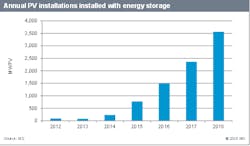The company released the forecast Monday at the SNEC 9th (2015) International Photovoltaic Power Generation Conference & Exhibition in Shanghai.
IHS said that the figures arise from a very optimistic scenario, with moderate policies and rapid decrease in battery prices.
“Rising demand for electricity and increasing renewable penetration are driving a need for more energy storage,” said Isabella Ni, senior analyst for energy storage and PV demand
The high price of batteries continues to thwart the energy storage market. However, a significant drop in cost is ahead; lithium-ion battery prices are likely to fall by 40 percent over the next three years.
“Lithium-ion is currently the technology to beat, and will account for the majority of the grid-connected PV energy storage market,” said Ni.
The rise in energy storage is linked to the continued demand for solar photovoltaics, which IHS forecasts will grow as much as 30 percent in 2015, reaching 57 GW, 10 times the size of the market just seven years ago.
“For the third year running, China will be the largest end-market and the key driver of global demand in 2015,” said Ash Sharma, senior research director for IHS. The other top growth markets will be Japan, the United States, United Kingdom, and India.
IHS also sees growth returning to the PV inverter sector, with sales 10 percent higher in 2018 than in 2014. The analysts peg the market at $6.6 billion in 2014 and $7.5 billion in 2018. Global inverter unit shipments will increase to nearly 70 GW of alternating current (AC) in 2018, due to strong growth in China, Japan, and emerging markets, according to IHS.
Meanwhile, average global inverter prices decrease by 9 percent each year, to $0.11/W in 2018 from $0.17/W in 2013, under the IHS forecast.
The solar conference is being held this week concurrent with the International Solar Energy and Green Building Conference & Exhibition.
Follow EnergyEfficiencyMarkets.com on Twitter @EfficiencyMkts.







